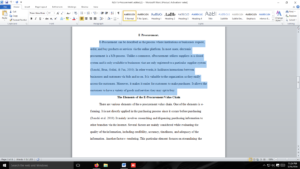Consider Table 1.1 in the Learning Activity titled “Why Organizations Build Teams.” What effect do teams have on performance? Please give two examples from the reading to illustrate your response. According to the reading, how do you determine whether a team is necessary? Do you agree that team-based organizations have more motivation and involvement? Now, think back to a time in your career when you worked on a team project. Were you more motivated and/or more involved in the project because you were on a team? Why or why not?
Why Organizations Build Teams
Introduction
Teams have a positive impact on the overall performance of organizations. After reading this section, consider your own team experiences. In what ways did you have a larger impact as a member of team than you would have had acting as an individual? Record your response in your Learning Journal.
Why do major organizations now rely more and more on teams to improve operations? Executives at Xerox have reported that team-based operations are 30% more productive than conventional operations. General Mills says that factories organized around team activities are 40% more productive than traditionally organized factories. According to in-house studies at Shenandoah Life Insurance, teams have cut case-handling time from twenty-seven to two days and virtually eliminated service complaints. FedEx says that teams reduced service errors (lost packages, incorrect bills) by 13% in the first year (Fisher, 2008; Greenberg & Baron, pp. 315–316).
Today it seems obvious that teams can address a variety of challenges in the world of corporate activity. Before we go any further, however, we should remind ourselves that data like those we’ve just cited aren’t necessarily definitive. For one thing, they may not be objective: companies are more likely to report successes than failures. As a matter of fact, teams don’t always work. Indeed, according to one study, team-based projects fail 50 to 70% of the time (Greenberg & Baron, 2008, p. 316; Thomson, 2008, p. 5).
The Effect of Teams on Performance
Research shows that companies build and support teams because of their effect on overall workplace performance, both organizational and individual. If we examine the impact of team-based operations according to a wide range of relevant criteria—including product quality, worker satisfaction, and quality of work life, among others—we find that overall organizational performance improves. Table 1.1 lists several areas in which we can analyze workplace performance and indicates the percentage of companies that have reported improvements in each area.
Table 1.1 Effect of Teams on Workplace Performance
| Area of Performance |
Percentage of Firms Reporting Improvement |
| Product and service quality |
70 |
| Customer service |
67 |
| Worker satisfaction |
66 |
| Quality of work life |
63 |
| Productivity |
61 |
| Competitiveness |
50 |
| Profitability |
45 |
| Absenteeism/turnover |
23 |
Adapted from Creating High Performance Organizations: Practices and Results of Employee Involvement and Total Quality in Fortune 1000 Companies, by E. E. Lawler, S. A. Mohman, and G. E. Ledford, 1992, San Francisco: Wiley. Copyright 1992 John Wiley & Sons Inc. Reprinted with permission.
The early 1990s saw a dramatic rise in the use of teams within organizations, along with dramatic results such as the Miller Brewing Company increasing productivity 30% in the plants that used self-directed teams compared with those that used the traditional organization. This same method allowed Texas Instruments in Malaysia to reduce defects from 100 parts per million to 20 parts per million. In addition, Westinghouse reduced its cycle time from 12 weeks to two weeks, and Harris Electronics was able to achieve an 18% reduction in costs (Wellins, 1994). The team method has served countless companies over the years through both quantifiable improvements and more subtle individual worker-related benefits.
Companies such as Square D, a maker of circuit breakers, switched to self-directed teams and found that overtime on machines, like the punch press, dropped 70% under teams. Productivity increased because the setup operators were able to manipulate the work in much more effective ways than a supervisor could dictate (Moskal, 1998, p. 32). In 2001, clothing retailer Chico’s FAS was looking to grow its business. The company hired Scott Edmonds as president, and two years later revenues had almost doubled from $378 million to $760 million. By 2006, revenues were $1.6 billion, and Chico’s had nine years of double-digit same-store sales growth. The company has continued to do well even after his departure; in 2012 sales were over $2 billion. What did Edmonds do to get these results? He created a horizontal organization “ruled by high-performance teams with real decision-making clout and accountability for results, rather than by committees that pass decisions up to the next level or toss them over the wall into the nearest silo.”
The use of teams also began to increase because advances in technology have resulted in more complex systems that require contributions from multiple people across the organization. Overall, team-based organizations have more motivation and involvement, and teams can often accomplish more than individuals (Cannon-Bowers & Salas, 2001). It is no wonder organizations are relying on teams more and more.
Do We Need a Team?
Teams are not a cure-all for organizations. To determine whether a team is needed, organizations should consider whether a variety of knowledge, skills, and abilities are needed, whether ideas and feedback are needed from different teams within the organization, how interdependent the tasks are, if wide cooperation is needed to get things done, and whether the organization would benefit from shared goals (Rees, 1997). If the answer to these questions is “yes,” then a team or teams might make sense. For example, research shows that the more team members perceive that outcomes are interdependent, the better they share information and the better they perform (De Dreu, 2007).
Note. Adapted from “The Team and the Organization,” by K. Collins, 2014, Exploring Business, Chapter 8, Section 1. Copyright 2014 by Flat World Knowledge, Inc.; “Understanding Team Design Characteristics,” by M. Carpenter, T. Bauer, B. Erdogan, & J. Short, 2013, Principles of Management, Chapter 12, Section 2. Copyright 2013 by Flat World Knowledge, Inc.
Requirements: More than 15 characters, less than 3000 characters
Answer preview
Consequently, the reading reinforces that team-based organizations often exhibit more significant involvement and motivation. Teams galvanize individuals’ collective strengths, heightening motivation through collaboration and shared accountability (Salas et al., 2015). Moreover, teams capitalize on diverse viewpoints and expertise, enhancing involvement and engagement in decision-making and problem-solving. This tenet aligns with the idea that collaboration and shared ownership foster commitment. Reflecting on my experience, I find teams integral in empowering individuals and enhancing involvement. It provides people with shared objectives and an opportunity to contribute unique perspectives. Thus, being part of a team is an opportunity to foster a sense of ownership over a project’s success.
[320 Words]

Value of Teams in Organizations













